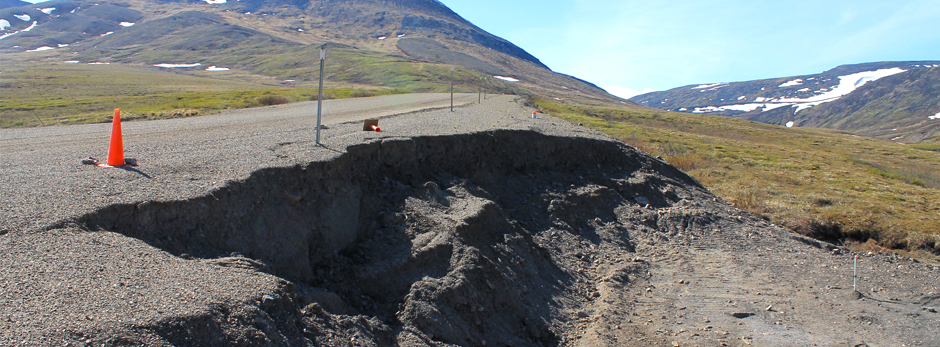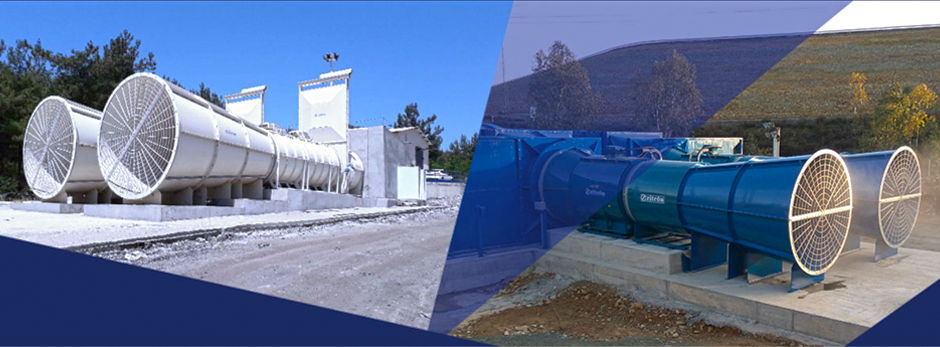Climate-Driven Impacts Present Risks to Infrastructure Constructed on Permafrost
By Christopher Stevens, in collaboration with The Northern Miner
DOWNLOAD PDF

PUBLICATION INFO
Author(s): Christopher Stevens, in collaboration with The Northern Miner
Date: April, 2021
First Presented: The Northern Miner
Type: Article
Mineral exploration and mining companies need to adopt a “proactive approach” to managing the climate-driven impacts on infrastructure built on permafrost, says Christopher Stevens, senior consultant at SRK Consulting (U.S.).
Surface infrastructure, including roads, airstrips, buildings, and tailings dams often relies on permafrost’s frozen state for stability. These structures, however, are becoming increasingly vulnerable to ground warming that causes the permafrost to thaw, which can lead to ground settlement and soil creep.
“Permafrost is not a static condition; it's dynamic and constantly changing,” explains Stevens, a geocryologist with over 18 years of experience working on mining, transportation, and oil and gas projects in the U.S., Canada, Russia, and Greenland.
“It has complex temperature-dependent properties that alter the hydraulic and mechanical properties of the soil. At some sites, ground warming is degrading the permafrost, resulting in deeper seasonal thaw and changes in ground stability.”
Scientists and engineers widely accept permafrost is changing due to climate-driven impacts. Less understood is what these changes could mean for operating mines or the long-term closure of projects located in permafrost settings.
Click here to read the full article
Click here to read the original article from The Northern Miner
Changing With The Climate - The Challenge of a Century
By Chris O'Brien, Victor Muñoz, Samantha Barnes, and Philippa Burmeister
DOWNLOAD PDF

Photo credit: Mining Journal's diggingforclimatechange.com
PUBLICATION INFO
Author(s): Chris O'Brien, Victor Muñoz, Samantha Barnes, and Philippa Burmeister
Date: May, 2021
First Presented: Mining Journal | www.diggingforclimatechange.com
Type: Article
This co-authored article addresses critical risks and opportunities to the mining industry in developing a greener economy.
When the history of the 21st Century is written, the struggle against COVID-19 will take a chapter. After all, it has changed, if only temporarily, the way we live and work. The book, however, will focus on climate change and the action taken to not only save the planet, but humanity.
If history was to judge that action as meaningful and effective, it would show that policy and decision-makers of today in government, industry, and finance understood three critical points.
First, the climate does not respond to emissions immediately. If humanity ceased all greenhouse gas (GHG) emissions in 2050, as many countries have committed to, the planet will continue to warm and the climate will continue to change for about 30 years.
Second, unlike almost all other environmental considerations, the impact of GHGs is not local, it is global. The climate does not respond to emission intensity, only total emissions.
Third, the greatest impacts from climate change will be felt in the developing world, jurisdictions with developing infrastructure and burgeoning mining. Successful mining depends on contented stakeholders. Although climate change may open new opportunities, it will also increase risk in the industry as storms intensify and weather patterns destabilise.
This thought leadership piece is featured by the Mining Journal on Digging for Climate Change.
By Chris O'Brien, Victor Muñoz, Samantha Barnes, and Philippa Burmeister
DOWNLOAD PDF

Photo credit: Mining Journal's diggingforclimatechange.com
PUBLICATION INFO
Author(s): Chris O'Brien, Victor Muñoz, Samantha Barnes, and Philippa Burmeister
Date: May, 2021
First Presented: Mining Journal | www.diggingforclimatechange.com
Type: Article
This co-authored article addresses critical risks and opportunities to the mining industry in developing a greener economy.
When the history of the 21st Century is written, the struggle against COVID-19 will take a chapter. After all, it has changed, if only temporarily, the way we live and work. The book, however, will focus on climate change and the action taken to not only save the planet, but humanity.
If history was to judge that action as meaningful and effective, it would show that policy and decision-makers of today in government, industry, and finance understood three critical points.
First, the climate does not respond to emissions immediately. If humanity ceased all greenhouse gas (GHG) emissions in 2050, as many countries have committed to, the planet will continue to warm and the climate will continue to change for about 30 years.
Second, unlike almost all other environmental considerations, the impact of GHGs is not local, it is global. The climate does not respond to emission intensity, only total emissions.
Third, the greatest impacts from climate change will be felt in the developing world, jurisdictions with developing infrastructure and burgeoning mining. Successful mining depends on contented stakeholders. Although climate change may open new opportunities, it will also increase risk in the industry as storms intensify and weather patterns destabilise.
This thought leadership piece is featured by the Mining Journal on Digging for Climate Change.
Mine Ventilation Tradeoff Study: Considering the Switch to Battery Electric Vehicles (BEV)
DOWNLOAD PDF

PUBLICATION INFO
Author(s): Nathan Wineinger
Date: June, 2021
First Presented: North American Mine Ventilation Symposium
Type: Presentation
EXPLORE BY TOPIC
Mine VentilationBattery Electric Vehicles
With the latest advances in battery technology, fast charging capabilities, and other technologies such as regenerative braking and more efficient battery electric systems, the use of Battery Electric Vehicles (BEVs) in the mining industry is becoming more advantageous. In 2019, SRK Consulting, performed a BEV analysis for a mine in Colombia. The purpose of this study was to consider an alternative ventilation system design for a previously completed feasibility study in which an all-diesel fleet was planned to be used for the mine. For this study, the mine requested that only the haul trucks and load-haul-dump loaders (LHD) be considered for conversion from diesel to battery electric. All other equipment would be left as diesel as in the previous study. This paper presents the ventilation assumptions which were made to complete this analysis and a discussion of the results. The results of the study showed significant reductions in the ventilation system power and infrastructure requirements with battery electric haul trucks and loaders compared to their diesel equivalents, but these savings depend on the changes implemented and the level of risk willing to be taken for a switch to BEVs.
Click here to download the full presentation
Click here to watch the video presentation
DOWNLOAD PDF

PUBLICATION INFO
Author(s): Nathan Wineinger
Date: June, 2021
First Presented: North American Mine Ventilation Symposium
Type: Presentation
EXPLORE BY TOPIC
Mine VentilationBattery Electric Vehicles
With the latest advances in battery technology, fast charging capabilities, and other technologies such as regenerative braking and more efficient battery electric systems, the use of Battery Electric Vehicles (BEVs) in the mining industry is becoming more advantageous. In 2019, SRK Consulting, performed a BEV analysis for a mine in Colombia. The purpose of this study was to consider an alternative ventilation system design for a previously completed feasibility study in which an all-diesel fleet was planned to be used for the mine. For this study, the mine requested that only the haul trucks and load-haul-dump loaders (LHD) be considered for conversion from diesel to battery electric. All other equipment would be left as diesel as in the previous study. This paper presents the ventilation assumptions which were made to complete this analysis and a discussion of the results. The results of the study showed significant reductions in the ventilation system power and infrastructure requirements with battery electric haul trucks and loaders compared to their diesel equivalents, but these savings depend on the changes implemented and the level of risk willing to be taken for a switch to BEVs.
Click here to download the full presentation
Click here to watch the video presentation
Opportunities to Reduce Risk by Mainstreaming Climate Change in Mining
By Philippa Burmeister
DOWNLOAD PDF
PUBLICATION INFO
Author(s): Philippa Burmeister
Date: May, 2021
First Presented: Mining Journal |www.diggingforclimatechange.com
Type: Article
EXPLORE BY TOPIC
Climate Change
Climate change remains a critical risk to a wide variety of sectors. To address the concerns many international protocols and agreements have been established to manage climate change and set internationally binding emission reduction targets. The policies and targets are continually being reviewed in line with the latest technical input, but the intent remains to reduce greenhouse gas (GHG) emissions and mitigate the impacts of climate change through adaptation.
By Philippa Burmeister
DOWNLOAD PDF

PUBLICATION INFO
Author(s): Philippa Burmeister
Date: May, 2021
First Presented: Mining Journal |www.diggingforclimatechange.com
Type: Article
EXPLORE BY TOPIC
Climate Change
Climate change remains a critical risk to a wide variety of sectors. To address the concerns many international protocols and agreements have been established to manage climate change and set internationally binding emission reduction targets. The policies and targets are continually being reviewed in line with the latest technical input, but the intent remains to reduce greenhouse gas (GHG) emissions and mitigate the impacts of climate change through adaptation.
No comments:
Post a Comment